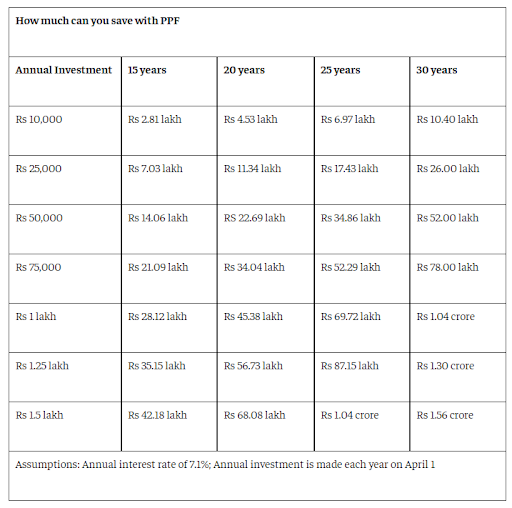When it comes to tax-saving investment products, the Public Provident Fund (PPF) in an option that is popular among many. Here is a look at seven reasons why the PPF is a preferred fixed income, tax-saving investment option for long term goals like retirement.
1) Triple tax exemption status
PPF is one of the few investment products that enjoys the benefit of triple tax exemptions, i.e., the exempt-exempt-exempt (EEE) status. What this mean is that you get tax exemption at the time of investment, accrual, and withdrawal.
It offers up to Rs 1.5 lakh deduction on investment made in each financial year under section 80C of the Income-tax Act, 1961. The interest that is earned each year is also exempted from tax. Thirdly, the accumulated corpus that you withdraw on maturity is also exempted from tax which makes it a tax-free income.
2) One of the highest interest rates among fixed income products
The Employees’ Provident Fund (EPF) currently offers the highest interest rate among fixed-income products that have government backing. For FY2020-21, EPF is offering 8.5%. However, this investment option is limited to salaried individuals. The PPF, on the other hand, is an investment product that even self-employed people can invest. The current interest rate on PPF is 7.1% (for the quarter ending June 30, 2021), which is higher than 6.8% offered on other small savings schemes like the National Savings Certificate (NSC) and 6.7% offered on Post Office 5-year Time Deposit. PPF interest rate is often not far behind the EPF rate, however, there have only been a few occasions when the PPF interest rate was higher than the EPF rate.
If you are a conservative investor looking for tax saving with assured return and safety of your investment, then PPF is one of the best options. When at present most of the large banks are giving 5.5% or lower interest rate on their 5-year tax saving FDs, the interest rate offered on PPF certainly comes with a good premium. While safety on a bank FD is limited to Rs 5 lakh offered by the Deposit Insurance and Credit Guarantee Corporation, the return that you get on your FDs is not exempted from tax. Moreover, though Sukanya Samriddhi and Senior Citizen Savings Scheme offer higher interest rates compared to PPF, these are for meant for specific purposes and available only for a limited set for investors.
6) Even aggressive investors can diversify through PPF
Even an investor with a high risk appetite can keep some part of his/her investment in debt products to diversify their portfolio. If the investment is for a long-term goal, then PPF is an option for such aggressive investors as well as it gives the desired stability and optimum return in the debt portion of the portfolio.
7) A must have for investors in the highest income tax bracket
The section 80C benefit may not be relevant for most investors in the highest income tax bracket as they have other avenues to utilise such as EPF, children’s education fee, home loan principal, term insurance premium etc. However, the tax exempted nature of return makes PPF a far more appealing option especially when any income is taxed at a rate of 30% or more. With PFF, investors can build a corpus which is completely tax free.















.gif)
0 Comments